Dmitri Ragano's Blog
March 1, 2015
Tomorrow Girl - a story of China and America
My latest short story is called Tomorrow Girl.
USA Network commissioned me to write an original international flash fiction piece. It's part of the promotional campaign for the new TV show DIG, a thriller set in Jersualem from the producers of Heroes and Homeland. Creating spin off fiction surrounding a TV show is an old concept. I used to read the Stars Wars novelizations as a kid. More recently there were the "pre-quel" novels and audio books they made for Homeland that go into the back story of Adrian Brody and Carrie Bradshaw.
For the launch of DIG, USA Network is throwing social media into the mix, reaching out to contributors and influencers in global online fiction communities like Wattpad to create original fiction.
In the case of DIG, I was contacted along with other popular writers for the Wattpad, since my novels Employee of the Year and The Fugitive Grandma has consistently ranked among most popular titles in the mystery category for the past 2 years.
For the USA Network piece, I didn't have to write with the plot and characters from the show DIG. Instead I could choose any story as long as 1) it was in the international thriller/mystery genre 2) I could turn it in within the deadline that basically gave me one weekend to write the story. (It's definitely that fastest I've written a story since my college days.)
 Shanghai. The view from the Bund
Shanghai. The view from the Bund
Tomorrow Girl is based on my visit to China last year as well as the American Girl craze that is so popula here in the US, where parents shell out $600 per doll.
China is the world's factory where everything is made from blue jeans to iPads. In America, we take it for granted that nearly everything in our life is made by strangers whose lives we don't even try to understand.
At the same time, Chinese and Americans are constantly getting closer through this process of economic integration. We meet each other and find we share the same dreams and aspirations. The future depends on people from different languages, cultures, governments, classes, etc. engaging and solving problems together. So it seemed like a fun theme to explore for a thriller.
 Me in Suzhou, July 2014You can read Tomorrow Girl on Wattpad. Thanks again to Wattpad and USA Network for a great opportunity to be part of the DIG Wattpad campaign. DIG airs on March 5.
Me in Suzhou, July 2014You can read Tomorrow Girl on Wattpad. Thanks again to Wattpad and USA Network for a great opportunity to be part of the DIG Wattpad campaign. DIG airs on March 5.
USA Network commissioned me to write an original international flash fiction piece. It's part of the promotional campaign for the new TV show DIG, a thriller set in Jersualem from the producers of Heroes and Homeland. Creating spin off fiction surrounding a TV show is an old concept. I used to read the Stars Wars novelizations as a kid. More recently there were the "pre-quel" novels and audio books they made for Homeland that go into the back story of Adrian Brody and Carrie Bradshaw.
For the launch of DIG, USA Network is throwing social media into the mix, reaching out to contributors and influencers in global online fiction communities like Wattpad to create original fiction.
In the case of DIG, I was contacted along with other popular writers for the Wattpad, since my novels Employee of the Year and The Fugitive Grandma has consistently ranked among most popular titles in the mystery category for the past 2 years.
For the USA Network piece, I didn't have to write with the plot and characters from the show DIG. Instead I could choose any story as long as 1) it was in the international thriller/mystery genre 2) I could turn it in within the deadline that basically gave me one weekend to write the story. (It's definitely that fastest I've written a story since my college days.)
 Shanghai. The view from the Bund
Shanghai. The view from the BundTomorrow Girl is based on my visit to China last year as well as the American Girl craze that is so popula here in the US, where parents shell out $600 per doll.
China is the world's factory where everything is made from blue jeans to iPads. In America, we take it for granted that nearly everything in our life is made by strangers whose lives we don't even try to understand.
At the same time, Chinese and Americans are constantly getting closer through this process of economic integration. We meet each other and find we share the same dreams and aspirations. The future depends on people from different languages, cultures, governments, classes, etc. engaging and solving problems together. So it seemed like a fun theme to explore for a thriller.
 Me in Suzhou, July 2014You can read Tomorrow Girl on Wattpad. Thanks again to Wattpad and USA Network for a great opportunity to be part of the DIG Wattpad campaign. DIG airs on March 5.
Me in Suzhou, July 2014You can read Tomorrow Girl on Wattpad. Thanks again to Wattpad and USA Network for a great opportunity to be part of the DIG Wattpad campaign. DIG airs on March 5.
Published on March 01, 2015 10:15
December 30, 2014
Silicon Valley
Silicon Valley is still a place of dreams and wonder. It occupies a place in our hopes and imagination that Wall Street could never hope to fill. My first experience with the place came in 1994 as a temp on the Menlo Park office of Morgan Stanley, where investment bankers prepared the IPO for Netscape and financed the first generation of Internet companies.
Peter Thiel's "Zero to One" was the best business book I read in 2014. There's a lot to disagree with in Thiel's thinking but I am with him on the importance of innovation and entrepreneurship. And I share his faith in our ability to think big and create a better future.
Here's my review of his book in the Pittburgh Post-Gazette.
Happy 2015 and here's to becoming part of a "conspiracy to change the world".
Peter Thiel's "Zero to One" was the best business book I read in 2014. There's a lot to disagree with in Thiel's thinking but I am with him on the importance of innovation and entrepreneurship. And I share his faith in our ability to think big and create a better future.
Here's my review of his book in the Pittburgh Post-Gazette.
Happy 2015 and here's to becoming part of a "conspiracy to change the world".
Published on December 30, 2014 09:20
December 8, 2014
The Guardians - Finalist in Little Tokyo Short Story Contest
Little Tokyo is one of my favorite historical neighborhoods in Los Angeles. When the Little Tokyo Historical Society announced a short story contest last year it seemed like the perfect setting for a story based on my past experiences as a crime reporter in California and as a manager of a "gaijin house" in the Setagaya Ward of Tokyo, a place where I came into contact with many drifters living on the fringes between American and Japanese society.
The Nio guardians or Kongorikishi are two muscular, otherwordly figures that stand at the gates of many temples in Japan. It is said that they are inspired by warriors who traveled with the Buddha to protect him.
Within the pacifist tradition of Buddhism, stories of the Nio guardians justify the use of force to protect sacred values and beliefs against evil forces.
For me they have always been compelling representations of the duality of human nature. Nothing is more tranquil than a Buddhist temple. And nothing more fierce than the faces of the guardians that stand at the gates.
 Nio guardians in Mount Koya, Japan
Nio guardians in Mount Koya, Japan
The Japanese American National Museum has posted The Guardians, a finalist in the Little Tokyo Short Story contest. A cast of contemporary Japanese and American characters acts out a modern day tale of Kongorikishi.
Thanks to Naomi Hirahara for her encouragement in the writing of this story.
The Nio guardians or Kongorikishi are two muscular, otherwordly figures that stand at the gates of many temples in Japan. It is said that they are inspired by warriors who traveled with the Buddha to protect him.
Within the pacifist tradition of Buddhism, stories of the Nio guardians justify the use of force to protect sacred values and beliefs against evil forces.
For me they have always been compelling representations of the duality of human nature. Nothing is more tranquil than a Buddhist temple. And nothing more fierce than the faces of the guardians that stand at the gates.
 Nio guardians in Mount Koya, Japan
Nio guardians in Mount Koya, JapanThe Japanese American National Museum has posted The Guardians, a finalist in the Little Tokyo Short Story contest. A cast of contemporary Japanese and American characters acts out a modern day tale of Kongorikishi.
Thanks to Naomi Hirahara for her encouragement in the writing of this story.
Published on December 08, 2014 06:03
The Guardians - My Entry in the Little Tokyo Short Story Contest
Little Tokyo is one of my favorite historical neighborhoods in Los Angeles. When the Little Tokyo Historical Society announced a short story contest last year it seemed like the perfect setting for a story based on my past experiences as a crime reporter in California and as a manager of a "gaijin house" in the Setagaya Ward of Tokyo, a place where I came into contact with many drifters living on the fringes between American and Japanese society.
The Nio guardians or Kongorikishi are two muscular, otherwordly figures that stand at the gates of many temples in Japan. It is said that they are inspired by warriors who traveled with the Buddha to protect him.
Within the pacifist tradition of Buddhism, stories of the Nio guardians justify the use of force to protect sacred values and beliefs against evil forces.
For me they have always been compelling representations of the duality of human nature. Nothing is more tranquil than a Buddhist temple. And nothing more fierce than the faces of the guardians that stand at the gates.
 Nio guardians in Mount Koya, Japan
Nio guardians in Mount Koya, Japan
The Japanese American National Museum has posted The Guardians, a finalist in the Little Tokyo Short Story contest. A cast of contemporary Japanese and American characters acts out a modern day tale of Kongorikishi.
Thanks to Naomi Hirahara for her encouragement in the writing of this story.
The Nio guardians or Kongorikishi are two muscular, otherwordly figures that stand at the gates of many temples in Japan. It is said that they are inspired by warriors who traveled with the Buddha to protect him.
Within the pacifist tradition of Buddhism, stories of the Nio guardians justify the use of force to protect sacred values and beliefs against evil forces.
For me they have always been compelling representations of the duality of human nature. Nothing is more tranquil than a Buddhist temple. And nothing more fierce than the faces of the guardians that stand at the gates.
 Nio guardians in Mount Koya, Japan
Nio guardians in Mount Koya, JapanThe Japanese American National Museum has posted The Guardians, a finalist in the Little Tokyo Short Story contest. A cast of contemporary Japanese and American characters acts out a modern day tale of Kongorikishi.
Thanks to Naomi Hirahara for her encouragement in the writing of this story.
Published on December 08, 2014 06:03
The Guardians
The Nio guardians or Kongorikishi are two muscular, otherwordly figures that stand at the gates of many temples in Japan. It is said that they are inspired by warriors who traveled with the Buddha to protect him.
Within the pacifist tradition of Buddhism, stories of the Nio guardians justify the use of force to protect sacred values and beliefs against evil forces.
For me they have always been compelling representations of the duality of human nature. Nothing is more tranquil than a Buddhist temple. And nothing more fierce than the faces of the guardians that stand at the gates.
 Nio guardians in Mount Koya, Japan
Nio guardians in Mount Koya, Japan
The Japanese American National Museum has posted The Guardians, a finalist in the Little Tokyo Short Story contest. A cast of contemporary Japanese and American characters acts out a modern day tale of Kongorikishi.
Thanks to Naomi Hirahara for her encouragement in the writing of this story.
Within the pacifist tradition of Buddhism, stories of the Nio guardians justify the use of force to protect sacred values and beliefs against evil forces.
For me they have always been compelling representations of the duality of human nature. Nothing is more tranquil than a Buddhist temple. And nothing more fierce than the faces of the guardians that stand at the gates.
 Nio guardians in Mount Koya, Japan
Nio guardians in Mount Koya, JapanThe Japanese American National Museum has posted The Guardians, a finalist in the Little Tokyo Short Story contest. A cast of contemporary Japanese and American characters acts out a modern day tale of Kongorikishi.
Thanks to Naomi Hirahara for her encouragement in the writing of this story.
Published on December 08, 2014 06:03
August 3, 2014
How to Be a Star on Wattpad
A year ago Wattpad began promoting The Fugitive Grandma as a Featured Story. Since then it has attracted hundreds of thousands readers all over the world. I wrote about my Wattpad experience on Martin Ott's Writeliving blog.
Do I wish all those readers had paid for my book instead of reading it for free? Of course, because then I'd actually be making money and have a shot at writing fiction as a career instead of doing it on the occasional weekend or whenever I can squeeze in time in an airport. But I am incredibly grateful for the chance to be connected to a global audience for my story.
Do I wish all those readers had paid for my book instead of reading it for free? Of course, because then I'd actually be making money and have a shot at writing fiction as a career instead of doing it on the occasional weekend or whenever I can squeeze in time in an airport. But I am incredibly grateful for the chance to be connected to a global audience for my story.
Published on August 03, 2014 01:46
October 28, 2013
Bangalore
"In all movements, in every great mass of humanity, it is the Spirit of the Time, that Europe calls the Zeitgeist and India Kala, who expresses himself. The very names are deeply significant. Kali, the Mother of all and destroyer of all, is the Shakti that works in secret in the heart of humanity manifesting herself in the perpetual surge of men, institutions and movements."
 Overlooking central Bangalore from the Oakwood in UB city.
Overlooking central Bangalore from the Oakwood in UB city.
A century ago Sri Aurobindo predicted the spirit of time would bring a convergence of ideas from the East and the West. He believed that philosophic concepts from Hinduism would help bridge the conflict and divisions that had arisen in European notions of science and religion, reconciling faith, reason and other systems of belief, giving mankind deeper and more powerful methods of understanding and problem solving. This would lead to new understandings among future generations and new interactions among people throughout the world.
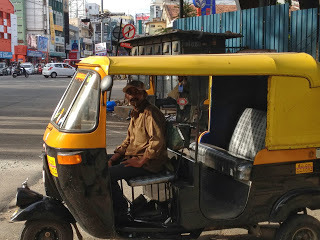 An electric rickshaw driver near MG Road.
An electric rickshaw driver near MG Road.
In modern day Bangalore, the technology hub that has become India's fastest growing city, the flow of communication and transformation is as constant as the traffic and energy pulsing through this chaotic city. Like many technology workers, I come here as part of a global team that spans the countries and cultures of the globe. We work around the clock on Internet projects that follow the sun through every time zone and continent. Emails, Skype and web conferences connect us from different locations... we try to choose a common time to talk once a day, a single hour to unite us across the time zones.
 Modern and ancient ways mix in urban India: a horse and motorbike share the sidewalk during the evening commute.
Modern and ancient ways mix in urban India: a horse and motorbike share the sidewalk during the evening commute.
As more of us spend our careers working with people in different parts of the world, it makes me wonder what will happen to the nation state in the future. How will future Americans think about their national identity through the lens of their daily experiencing of work, life and play with people around the globe?
A great article in Foreign Policy talks about the experience and expectations of younger generations, who have really only experienced a world of corporate and political leaders who consistently fail them, whether it's sending them off to ill-conceived foreign military adventures or neglecting the basic infrastructure of jobs and educations. As Charles Stross writes in "Spy Kids":
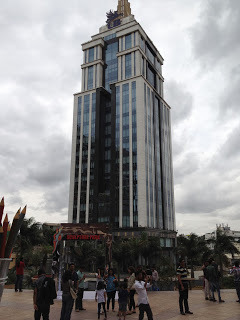 UB City, a shopping center with Louis Vuitton, Italian food and rave clubs for Westernized, upper middle class Bangalore.
UB City, a shopping center with Louis Vuitton, Italian food and rave clubs for Westernized, upper middle class Bangalore.
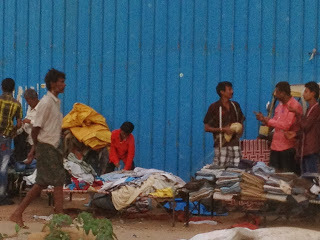 Street vendors in Bangalore.
Street vendors in Bangalore.
 Construction in UB City.
Construction in UB City.
In my 2012 novel The Voting Machine the hero Temo McCarthy works at a call center that is gutted when the new CEO Chet Castle ships all the jobs to a new offshore site in Bangalore. Chet warns Temo that he needs to get ready for a future that will be very different:
"We've got to evolve. We've got to break through the barriers of our genes that only llet us care about the 150 people in our circle. We're connected to everyone, everywhere. One planet. One species. The old tribes have scattered. The old institutions don't matter. We're stepping out of an old world into a new one. And none of us knows our way around in this new world. So we wander. We stumble."
 Overlooking central Bangalore from the Oakwood in UB city.
Overlooking central Bangalore from the Oakwood in UB city.A century ago Sri Aurobindo predicted the spirit of time would bring a convergence of ideas from the East and the West. He believed that philosophic concepts from Hinduism would help bridge the conflict and divisions that had arisen in European notions of science and religion, reconciling faith, reason and other systems of belief, giving mankind deeper and more powerful methods of understanding and problem solving. This would lead to new understandings among future generations and new interactions among people throughout the world.
 An electric rickshaw driver near MG Road.
An electric rickshaw driver near MG Road.In modern day Bangalore, the technology hub that has become India's fastest growing city, the flow of communication and transformation is as constant as the traffic and energy pulsing through this chaotic city. Like many technology workers, I come here as part of a global team that spans the countries and cultures of the globe. We work around the clock on Internet projects that follow the sun through every time zone and continent. Emails, Skype and web conferences connect us from different locations... we try to choose a common time to talk once a day, a single hour to unite us across the time zones.
 Modern and ancient ways mix in urban India: a horse and motorbike share the sidewalk during the evening commute.
Modern and ancient ways mix in urban India: a horse and motorbike share the sidewalk during the evening commute.As more of us spend our careers working with people in different parts of the world, it makes me wonder what will happen to the nation state in the future. How will future Americans think about their national identity through the lens of their daily experiencing of work, life and play with people around the globe?
A great article in Foreign Policy talks about the experience and expectations of younger generations, who have really only experienced a world of corporate and political leaders who consistently fail them, whether it's sending them off to ill-conceived foreign military adventures or neglecting the basic infrastructure of jobs and educations. As Charles Stross writes in "Spy Kids":
 UB City, a shopping center with Louis Vuitton, Italian food and rave clubs for Westernized, upper middle class Bangalore.
UB City, a shopping center with Louis Vuitton, Italian food and rave clubs for Westernized, upper middle class Bangalore."Generation Y's parents are Generation X. Generation Y comprises the folks who serve your coffee in Starbucks and build software at Google. Generation Y has never thought of jobs as permanent things. Most Generation Y folks will stare at you blankly if you talk about loyalty to one's employer; the old feudal arrangement ("we'll give you a job for life and look after you as long as you look out for the Organization") is something their grandparents ranted about, but it's about as real to them as the divine right of kings. Employers like Google or Facebook that provide good working conditions are the exception, not the rule. Employers are alien hive-mind colony intelligences that will fuck you over for the bottom line on the quarterly balance sheet. They'll give you a laptop and tell you to hot-desk or work at home so that they can save money on office floor space and furniture. They'll dangle the offer of a permanent job over your head but keep you on a zero-hours contract for as long as is convenient.
 Street vendors in Bangalore.
Street vendors in Bangalore.On the other hand: Generation Y has grown up in a world where travel is cheap and communication is nearly free. Their cultural zeitgeist is less parochial than that of their grandparents, more global, infused with Japanese anime and Swedish heavy metal, as well as local media produce. This is the world they grew up in: This is the world that defines their expectations."
 Construction in UB City.
Construction in UB City.In my 2012 novel The Voting Machine the hero Temo McCarthy works at a call center that is gutted when the new CEO Chet Castle ships all the jobs to a new offshore site in Bangalore. Chet warns Temo that he needs to get ready for a future that will be very different:
"We've got to evolve. We've got to break through the barriers of our genes that only llet us care about the 150 people in our circle. We're connected to everyone, everywhere. One planet. One species. The old tribes have scattered. The old institutions don't matter. We're stepping out of an old world into a new one. And none of us knows our way around in this new world. So we wander. We stumble."
Published on October 28, 2013 06:51
October 20, 2013
Jesus Malverde
My novel "The Voting Machine" describes the fictional drug cartel called Los Empresarios. Through course of the election thriller, a boss from the cartel oversees expansion of narcotics trade into the United States, attempting to make inroads into not just the American economy but also the political system.
In some ways, Los Empresarios is loosely inspired by the real-life Sinaloa Cartel, which dominates production, supply, distribution and retail trade of drugs in Chicago and other parts of the United States. In its home country, the cartel is an enormous economic, political force led by a drug boss reputed to be worth billions of dollars.
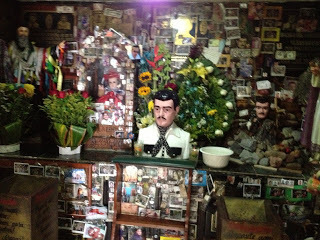 The Jesus Malverde shrine in Sinaloa
The Jesus Malverde shrine in Sinaloa
The Mexican drug trade has deep roots in the northwestern state of Sinaloa, a part of the country historically isolated and entrenched in poverty. I have always been interested in the mythology behind the cartels, which combines various elements of Mexican culture such as Catholic mysticism, economic populism and the outlaw/bandit ethos of the frontier.
Nothing embodies these themes better than the story of Jesus Malverde, patron saint of the Mexican drug lords. A friend with ties to Sinaloa recently visited the capitol city of Culiacan, where he took these photos of Malverde's shrine and brought back the story of his life.
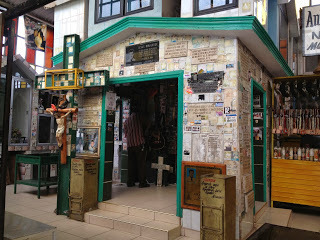 An external view of the shrine.
An external view of the shrine.
According to legend, Jesus Malverde was hero was a hero to the poor who lived around the turn of the 20th century. He stole from the rich and gave to the poor. Malverde means "bad green" because Jesus would hide between the green trees when he was robbing the rich and then go back into the jungle.
One night he broke into the governors house with a sword and robbed him. The governor became angry and put a bounty on his head. Jesus realized that the governor's men were going to catch him sooner or later so he asked a compadre to turn him in.
The governor was determined not just to hang Malverde but to leave him hanging until his body rot in public view and deny him a proper burial. So when some poor farmer lost his cows and walked by Malverde's hanging corpse and the dead man's spirit called out to him: "I helped you when you were alive," the spirit reminded the poor farmer. "If you pull me down I willl help you get your cows back." The poor farmer pulled the hanging body down to the ground and all his cows reappeared, coming out of the jungle.
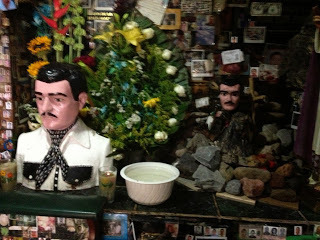 Rocks are a symbol of Malverde's reverence among the poor peasants.
Rocks are a symbol of Malverde's reverence among the poor peasants.
The local peasant couldn't bury Malverde's based on strict orders from the governor so he put some rocks around the body. And then more and more peasants came around and put rocks around and over the body along with coins and money.
In Malverde's shrine, rocks and money still carry a special symbolic significance. Dollar bills and coins are embedded into the walls and ceilings. Rocks are still piled at the shrine's centerpiece. There is still a place where visitors can make a petition for a wish and take a rock from the shrine. If your wish comes true you have to return with more rocks.
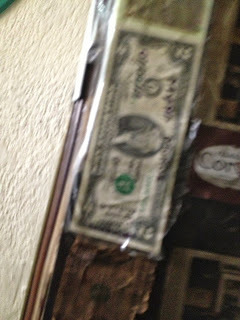 A dollar bill embedded in the ceiling.
A dollar bill embedded in the ceiling.
In some ways, Los Empresarios is loosely inspired by the real-life Sinaloa Cartel, which dominates production, supply, distribution and retail trade of drugs in Chicago and other parts of the United States. In its home country, the cartel is an enormous economic, political force led by a drug boss reputed to be worth billions of dollars.
 The Jesus Malverde shrine in Sinaloa
The Jesus Malverde shrine in SinaloaThe Mexican drug trade has deep roots in the northwestern state of Sinaloa, a part of the country historically isolated and entrenched in poverty. I have always been interested in the mythology behind the cartels, which combines various elements of Mexican culture such as Catholic mysticism, economic populism and the outlaw/bandit ethos of the frontier.
Nothing embodies these themes better than the story of Jesus Malverde, patron saint of the Mexican drug lords. A friend with ties to Sinaloa recently visited the capitol city of Culiacan, where he took these photos of Malverde's shrine and brought back the story of his life.
 An external view of the shrine.
An external view of the shrine.According to legend, Jesus Malverde was hero was a hero to the poor who lived around the turn of the 20th century. He stole from the rich and gave to the poor. Malverde means "bad green" because Jesus would hide between the green trees when he was robbing the rich and then go back into the jungle.
One night he broke into the governors house with a sword and robbed him. The governor became angry and put a bounty on his head. Jesus realized that the governor's men were going to catch him sooner or later so he asked a compadre to turn him in.
The governor was determined not just to hang Malverde but to leave him hanging until his body rot in public view and deny him a proper burial. So when some poor farmer lost his cows and walked by Malverde's hanging corpse and the dead man's spirit called out to him: "I helped you when you were alive," the spirit reminded the poor farmer. "If you pull me down I willl help you get your cows back." The poor farmer pulled the hanging body down to the ground and all his cows reappeared, coming out of the jungle.
 Rocks are a symbol of Malverde's reverence among the poor peasants.
Rocks are a symbol of Malverde's reverence among the poor peasants.The local peasant couldn't bury Malverde's based on strict orders from the governor so he put some rocks around the body. And then more and more peasants came around and put rocks around and over the body along with coins and money.
In Malverde's shrine, rocks and money still carry a special symbolic significance. Dollar bills and coins are embedded into the walls and ceilings. Rocks are still piled at the shrine's centerpiece. There is still a place where visitors can make a petition for a wish and take a rock from the shrine. If your wish comes true you have to return with more rocks.
 A dollar bill embedded in the ceiling.
A dollar bill embedded in the ceiling.
Published on October 20, 2013 06:37
August 7, 2013
SoCal Stories
California existed in fiction before it did in fact. The name comes from a Spanish adventure novel during the time of the Explorers, it refers to a mythical island ruled by women.
Sailing conquistadors found a new territory to the west of Mexico. They believed it was an island with a mystical dimension and named it accordingly.
Back then (just like now) the myth and reality of California often blurred into one another. For a century after discovery, most Spanish explorers still believed it was an island. Some are rumored to have carried boats across the Mojave Desert thinking they would need them when they reached the other side.
 Salt Creek Beach near my home in Orange CountyI have lived most of my adult life in the Golden State. I went to San Francisco at age 20 and made my way through college on ramen noodles and low wage jobs. I started making web sites during dotcom boom of the late 90s and never got rich but enjoyed every minute of it.
Salt Creek Beach near my home in Orange CountyI have lived most of my adult life in the Golden State. I went to San Francisco at age 20 and made my way through college on ramen noodles and low wage jobs. I started making web sites during dotcom boom of the late 90s and never got rich but enjoyed every minute of it.
Ten years ago I moved to Irvine, nestled in the heart of Orange County, which is transformed from the white, wealthy, intolerant enclave of the Nixon and Reagan years into a vibrant microcosm of the world. My neighborhood is home to a thriving mosque, a huge Chinese cultural center and community that is open-minded, multicultural and middle class. Most of my neighbors in the "OC" share my passion for a life of learning, sharing and creating over the endless material chase for a better car or a bigger house.
For me the romanticism of California, the sun, the beach, the mountains, the boundless spirit of optimism and reinvention, has never really died the way they said it was supposed. You’ll get cynical about the place, I was told before I moved here. But I never did.
Nor am I blind or insensitive to the enormous problems we have in the state: the inequality, the pollution, the crumbling public commitment to education and the environment.
California has been a place where people used their imagination and drive to push the limits, whether it was their limits, the limits of others or the very limits of earth’s resources.
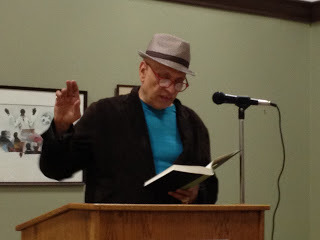 Walter Mosley reading from an Easy Rawlins' novel at the African American Art Musuem on Crenshaw in South LA.
Walter Mosley reading from an Easy Rawlins' novel at the African American Art Musuem on Crenshaw in South LA.
In many ways this is a very horrifying thing. In other ways it yields excitement and beauty.
That’s what makes it such a good story. That’s why an endless of succession of writers have mined this territory for amazing works across different parts of the thriller/mystery genre, starting with the foundational work of legends like Raymond Chandler and extending into contemporary greats like Don Winslow, Walter Mosley and Naomi Hirahara, each of them with their own unique and remarkable story of life, love and treachery in the Golden State.
More than anything, I still love California because it is a place where the creative life is still valued. And creativity is really all we have left to save us from ourselves.
 Naomi Hirahara at the Orange County Sisters in Crime meeting in Irvine.
Naomi Hirahara at the Orange County Sisters in Crime meeting in Irvine.
As Ray Bradbury said.
“Don't think. Thinking is the enemy of creativity. It's self-conscious, and anything self-conscious is lousy. You can't try to do things. You simply must do things.”
Sailing conquistadors found a new territory to the west of Mexico. They believed it was an island with a mystical dimension and named it accordingly.
Back then (just like now) the myth and reality of California often blurred into one another. For a century after discovery, most Spanish explorers still believed it was an island. Some are rumored to have carried boats across the Mojave Desert thinking they would need them when they reached the other side.
 Salt Creek Beach near my home in Orange CountyI have lived most of my adult life in the Golden State. I went to San Francisco at age 20 and made my way through college on ramen noodles and low wage jobs. I started making web sites during dotcom boom of the late 90s and never got rich but enjoyed every minute of it.
Salt Creek Beach near my home in Orange CountyI have lived most of my adult life in the Golden State. I went to San Francisco at age 20 and made my way through college on ramen noodles and low wage jobs. I started making web sites during dotcom boom of the late 90s and never got rich but enjoyed every minute of it.Ten years ago I moved to Irvine, nestled in the heart of Orange County, which is transformed from the white, wealthy, intolerant enclave of the Nixon and Reagan years into a vibrant microcosm of the world. My neighborhood is home to a thriving mosque, a huge Chinese cultural center and community that is open-minded, multicultural and middle class. Most of my neighbors in the "OC" share my passion for a life of learning, sharing and creating over the endless material chase for a better car or a bigger house.
For me the romanticism of California, the sun, the beach, the mountains, the boundless spirit of optimism and reinvention, has never really died the way they said it was supposed. You’ll get cynical about the place, I was told before I moved here. But I never did.
Nor am I blind or insensitive to the enormous problems we have in the state: the inequality, the pollution, the crumbling public commitment to education and the environment.
California has been a place where people used their imagination and drive to push the limits, whether it was their limits, the limits of others or the very limits of earth’s resources.
 Walter Mosley reading from an Easy Rawlins' novel at the African American Art Musuem on Crenshaw in South LA.
Walter Mosley reading from an Easy Rawlins' novel at the African American Art Musuem on Crenshaw in South LA.In many ways this is a very horrifying thing. In other ways it yields excitement and beauty.
That’s what makes it such a good story. That’s why an endless of succession of writers have mined this territory for amazing works across different parts of the thriller/mystery genre, starting with the foundational work of legends like Raymond Chandler and extending into contemporary greats like Don Winslow, Walter Mosley and Naomi Hirahara, each of them with their own unique and remarkable story of life, love and treachery in the Golden State.
More than anything, I still love California because it is a place where the creative life is still valued. And creativity is really all we have left to save us from ourselves.
 Naomi Hirahara at the Orange County Sisters in Crime meeting in Irvine.
Naomi Hirahara at the Orange County Sisters in Crime meeting in Irvine.As Ray Bradbury said.
“Don't think. Thinking is the enemy of creativity. It's self-conscious, and anything self-conscious is lousy. You can't try to do things. You simply must do things.”
Published on August 07, 2013 17:47
April 28, 2013
Ninjas and Samurai
I spent five years in Japan during my 20s and 30s. My time in that country was a transformative experience. Living in a foreign culture, interacting in a different language every day, can have the effect of stretching your personality and consciousness into areas you never knew existed. It's true what Charlemagne said "To possess a second language is to possess a second soul" because it redefines your thinking and opens your heart.
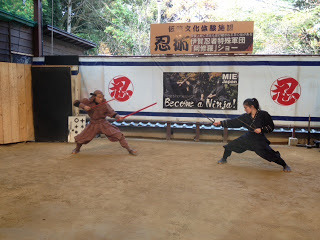 A mock battle between a samuari and a "kunoichi" (female version of a ninja) in Iga, Japan.
A mock battle between a samuari and a "kunoichi" (female version of a ninja) in Iga, Japan.
During at stay in Japan last year to visit my wife's family in the bustling, industrial city of Osaka, I took a trip to Iga, a town in Mie Prefecture that is known as one of the ancient birthplaces of the ninjas. It was a perfect place to do research for an upcoming book project, one set in medieval Japan when Ieyasu Tokugawa consolidated his rule of the country under the shoguns.
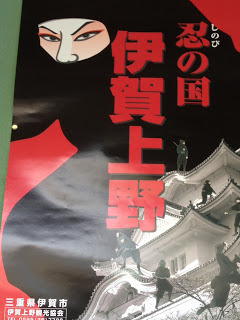 A poster for the town of Iga in Mie Prefecture, the "country of the ninjas".
A poster for the town of Iga in Mie Prefecture, the "country of the ninjas".
Ninjas played a special role in the feudal, war-torn period of medieval Japan between the 15th and 17th centuries. They were masters of covert warfare and espionage, possessing special skills that the formally trained samurai warriors lacked. The original ninja clans may have learned their techniques from Chinese mystic warriors according to Stephen Hayes famous book The Ninja and the Secret Fighting Art.
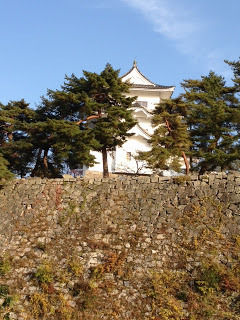 A castle in Iga, Japan.
A castle in Iga, Japan.
Ninjas (and their female counterparts, the Kunoichi) occupied a unique position in the social hierachy of feudal Japan: unlike the samurai and feudal lords, they were often recruited from the lower classes. They also organized their activities into specific roles: spy, scout, agitator or surprise attacker. In a society with rigid definition around an individual's role in society based on class, gender, etc., ninjas and kunoichi were mercenaries valued for their ability to transcend these social boundaries and play different roles. A ninja who came from humble origins might be valued for his ability to impersonate a noble warrior and penetrate enemy ranks. A kunoichi would be valued for ability to play different roles expertly, such as a Shinto shrine maiden or a palace geisha. She could wield tremendous power and influence in areas that were usually reserved for men in the danson jyohi (male dominated society) of traditional Japan.
Ninja clans would begin training their recruits from childhood in the mountains around Iga, with elaborate and painstaking lessons in balance and dexterity, such as making a young child stand on a tree branch all day long while remaining alert so he would not lose his balance.

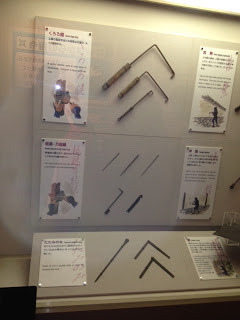 Ninja weapons on display in an Iga museum.There have been lots of books and films about the ninjas in popular culture. But I think there a few elements of the ninja society that haven't been explored and these will form the theme for one my upcoming novels. Post s on this blog form a sort of working diary of my research on this topic.
Ninja weapons on display in an Iga museum.There have been lots of books and films about the ninjas in popular culture. But I think there a few elements of the ninja society that haven't been explored and these will form the theme for one my upcoming novels. Post s on this blog form a sort of working diary of my research on this topic.
 A mock battle between a samuari and a "kunoichi" (female version of a ninja) in Iga, Japan.
A mock battle between a samuari and a "kunoichi" (female version of a ninja) in Iga, Japan.During at stay in Japan last year to visit my wife's family in the bustling, industrial city of Osaka, I took a trip to Iga, a town in Mie Prefecture that is known as one of the ancient birthplaces of the ninjas. It was a perfect place to do research for an upcoming book project, one set in medieval Japan when Ieyasu Tokugawa consolidated his rule of the country under the shoguns.
 A poster for the town of Iga in Mie Prefecture, the "country of the ninjas".
A poster for the town of Iga in Mie Prefecture, the "country of the ninjas".Ninjas played a special role in the feudal, war-torn period of medieval Japan between the 15th and 17th centuries. They were masters of covert warfare and espionage, possessing special skills that the formally trained samurai warriors lacked. The original ninja clans may have learned their techniques from Chinese mystic warriors according to Stephen Hayes famous book The Ninja and the Secret Fighting Art.
 A castle in Iga, Japan.
A castle in Iga, Japan.Ninjas (and their female counterparts, the Kunoichi) occupied a unique position in the social hierachy of feudal Japan: unlike the samurai and feudal lords, they were often recruited from the lower classes. They also organized their activities into specific roles: spy, scout, agitator or surprise attacker. In a society with rigid definition around an individual's role in society based on class, gender, etc., ninjas and kunoichi were mercenaries valued for their ability to transcend these social boundaries and play different roles. A ninja who came from humble origins might be valued for his ability to impersonate a noble warrior and penetrate enemy ranks. A kunoichi would be valued for ability to play different roles expertly, such as a Shinto shrine maiden or a palace geisha. She could wield tremendous power and influence in areas that were usually reserved for men in the danson jyohi (male dominated society) of traditional Japan.
Ninja clans would begin training their recruits from childhood in the mountains around Iga, with elaborate and painstaking lessons in balance and dexterity, such as making a young child stand on a tree branch all day long while remaining alert so he would not lose his balance.

 Ninja weapons on display in an Iga museum.There have been lots of books and films about the ninjas in popular culture. But I think there a few elements of the ninja society that haven't been explored and these will form the theme for one my upcoming novels. Post s on this blog form a sort of working diary of my research on this topic.
Ninja weapons on display in an Iga museum.There have been lots of books and films about the ninjas in popular culture. But I think there a few elements of the ninja society that haven't been explored and these will form the theme for one my upcoming novels. Post s on this blog form a sort of working diary of my research on this topic.
Published on April 28, 2013 08:34



